

Zero Waste Pattern: How To Create One Using Adobe Illustrator. Let me fume about zero-waste cutting. I must be the dissenter here.
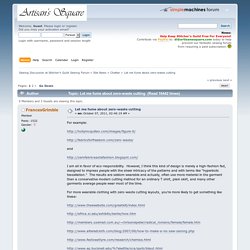
Let's look at a couple of Timo Rissanen's points:"fashion hasn’t offered much personal choice for a long time, if ever" I must agree with him/her here (I am no Finn, so I don't know if Timo is male or female), and I don't have to read the links, either. All we can do every "season" is buy the colors/fabrics and patterns available, or not. That's our choice. You can only choose what's available, whether you are shopping for RTW or fabric and patterns to make your own.
<snip>Zero waste is a goal and a conscious choice. But there is an enormous amount of ready-to-wear available, and a huge number of ways to combine garments. I live in San Francisco, where absolutely anything goes. Timo Rissanen: Fashion Creation Without Fabric Waste Creation: copyright and fashion design in Australia. While in Melbourne, a copyright infringement case involving two dresses got a bit of press.
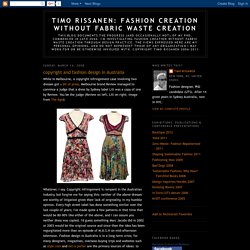
Melbourne brand Review managed to convince a judge that a dress by Sydney label Lili was a copy of one by Review. You be the judge (Review on left, Lili on right; image from The Age): Whatever, I say. Copyright infringement is rampant in the Australian industry, but forgive me for saying this: neither of the above dresses are worthy of litigation given their lack of originality, in my humble opinion. Every high street label has done something similar over the last couple of years; I've made quite a few patterns in that time that would be 80-90% like either of the above, and I can assure you neither dress was copied. What worries me is the precedent the two dresses above set. Zero waste pattern cutting book with free resources dwnloads. Table of content Preface 1.

Maja Stabel. 'Reverse Subtraction Cutting' lecture by Julian Roberts. Make/Use - zero waste fashion. Make/use: a modular system for zero-waste fashion. Subtraction Cutting by Julian Roberts. Seamwork Magazine. These days, Rissanen remains inspired by Vionnet, even as he continues to push the boundaries of zero-waste design.
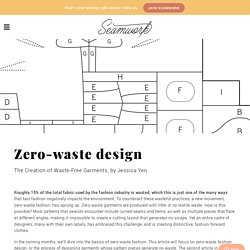
“Vionnet seemed to be endlessly fascinated by the possibilities created by the combination of fabric, the moving body, and gravity, and that is something that has stayed with me ever since I was a student,” he says. To the uninitiated, zero-waste design layouts look intimidating. The finished pattern looks like intricate interlocking puzzle pieces that emerged, fully formed, from thin air. However, Rissanen emphasizes the design process is an iterative one. His first pattern, fittings, and alterations focus on garment shape. This process can vary by garment type. Rissanen is quick to point out that design alone cannot solve the environmental, health, and social costs of fast fashion. Timo Rissanen. November. For this collection, as a part of my assessment, I need to have 3 market levels.

My Experimental range which you have seen the zero-waste system I developed, a mid level range and a budget range. I am currently working on the mid level range. I need to develop a new system for my pattern making… not a completely new system as it needs to work off and develop from the experimental system. It has taken me a while to get into the mindset of it and to go back to designing with pen and paper, but I think it is finally there. Hollymcquillan. Ecouterre. Zero Waste for The Melbourne Review. Tullia Jack Likes to think.
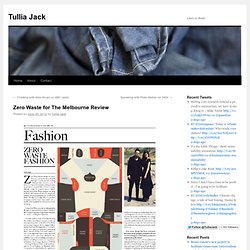
Skip to content ← Chatting with Alex Sloan on ABC radio Speaking with Peter Maher on 3AW → Timo Rissanen. …I am also writing up findings from my project.
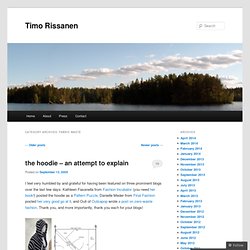
I’ve drawn a diagram that looks benign enough – for a moment even I thought, ‘Is that it?’ , after four years* – but when you really start thinking about it, it completely challenges what we conventionally perceive fashion design and patternmaking to be. Mostly patternmaking, though. But enough of that for now – no, I won’t post the diagram and no, I won’t elaborate just yet. Having seen others present my thoughts and ideas as their own a lot this year, I don’t feel safe sharing just yet.
In first semester first year: “This subject introduces students to the basic technical skills essential to begin interpreting design into a three dimensional form. In second semester first year: “This subject aims to further develop understanding and technical abilities in flat pattern making and garment construction. As for those exhibition photos, soon I hope. "ZERO WASTE"project, Zheng Cui Lan/Sirina graduation collection.
The essence of fashion is change – making it directly opposed to the principles of sustainability and sustainable design processes.
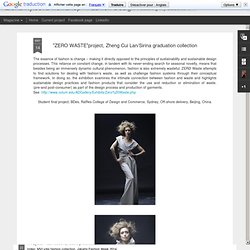
This reliance on constant change, in tandem with its never-ending search for seasonal novelty, means that besides being an immensely dynamic cultural phenomenon, fashion is also extremely wasteful. ZERØ Waste attempts to find solutions for dealing with fashion’s waste, as well as challenge fashion systems through their conceptual framework. In doing so, the exhibition examines the intimate connection between fashion and waste and highlights sustainable design practices and fashion products that consider the use and reduction or elimination of waste. (pre-and post-consumer) as part of the design process and production of garments. See.